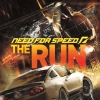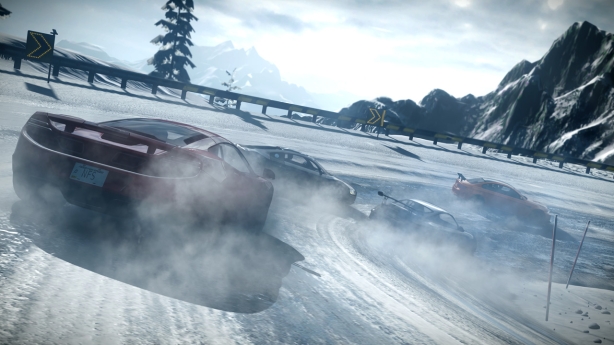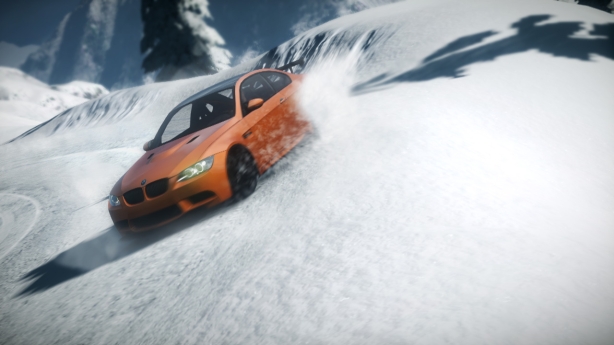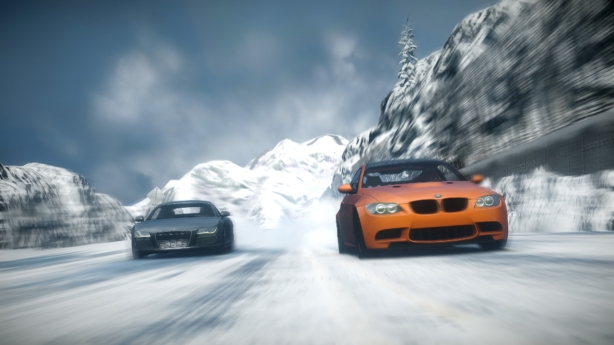Need for Speed: The Run Preview
 The Porsche; a vision in grey, wide and low with its painted red stripe splitting it down the middle, roars as it flies along the angry black tarmac. The sun beats down, expending every last drop of energy trying to bake the Arizona desert completely dry. Either side of the car the desert; sandy, lifeless and brown, stretches off towards the distant silver mountains. Empty beauty, devoid of life, harsh and unforgiving.
The Porsche; a vision in grey, wide and low with its painted red stripe splitting it down the middle, roars as it flies along the angry black tarmac. The sun beats down, expending every last drop of energy trying to bake the Arizona desert completely dry. Either side of the car the desert; sandy, lifeless and brown, stretches off towards the distant silver mountains. Empty beauty, devoid of life, harsh and unforgiving.
The Porsche cares about none of this; its sole aim is a BMW, quiet and calm though achingly fast, which is mere yards up the road and being further caught with every second. Ahead, the road veers hard and to the right, indecisively doubling back on itself as it slides down the mountain side. The Porsche pulls to the inside of the road, ready for the pass. The pure white BMW snaps on its brakes, ruby lights at its rear blazing into life for a split second before the Porsche does the same, slamming the break peddle to the floor. The extra momentum seems to push the Porsche by its opponent but the barrier at the edge of the road is waiting, the nimble sports car heaving under its own weight as it moves inevitably towards the railing and the sharp edge of the cliff.
It only takes a fraction of a second, but the molten black heat of the tyres find grip where there should be none, the back of perfectly engineered machine snaps round, starting the car in a graceful slide around the bend, the shrieking rubber and ghostly smoke a chilling accompaniment to a symphony of balance and power. The pale BMW is now just a shadow, left in the rear view mirror and fading like the tyre smoke against the baked dust of the American desert. The driver looks down, the illegal readout grafted onto his dashboard ticks down…141st place…140th place.
Only 139 to go.
It’s not difficult to see what EA are going for with Need for Speed: The Run. At least, now it isn’t. After a confused presentation at E3 which made the game look like it was largely comprised of Quick-Time Events disguised as disappointing, sub-Hollywood action sequences, it was important that this new showing of the game showed what The Run was really about.
It is a fascinating proposition.
Need for Speed: The Run is a game that, like Hot Pursuit, pits fast car against insanely fast car but, unlike its spiritual predecessor, commits to the ongoing narrative of a West to East coast race across the USA. This narrative binds the individual events together into an ongoing endeavour where each small victory is part of a larger goal. In tune with this, the game’s camera is close in on the action, perched tantalisingly near to the snarling exhausts, and it is emblematic of The Run’s new visceral, aggressive tone. But how does this new commitment to story affect “The Run”? Does it add to, or compromise, the fun of this racing game and is there a risk that the driving fundamentals (handling, spontaneity and great opponent AI) get lost in the midst of all these new ideas?
The first race on show was through the Arizona desert and saw the player attempting to pass ten cars and then hold the position over a three minute long course. It is here that the first of The Run’s unique propositions is put to the player: whilst the game is broken up into a series of small races, the developer is totally committed to creating the feeling you are driving in a huge, ongoing event. The aim for the level is to get from 149th position to 140th at which point, presumably, the player will start from that position at the beginning of the next driving challenge. It was an exciting sensation, with every pass an important element not only of the individual challenge but of the larger story that connects them all together, and it grants the game a unique atmosphere. It also raised a lot of questions. What happens if you don’t pass all the cars? Could you, for example, play the game to a finish and only come in the top thirty? What affect does your finishing position in one race have on the next? Does the story, played out in small cutscenes before and after races change depending on your position?
More questions were raised by EA’s handling of crashes. The handling in The Run is bullish and physical, with the cars feeling like they need to be wrestled around corners rather than thrown round with abandon. As such, in this brief demonstration it never felt as if the car was totally under control. Too fast into a corner and the car would simply not respond, but accelerate too quickly or slap on a burst of NOS before you were back in a straight line and the rear of the car would quickly step out of shape and try and hurl you into the rock walls. Crashes were regular occurrences and when they happened, rather than the player being reset to the track near the accident site with the race timer still running, the player was reset to the most recent course checkpoint with the time reset to the moment the player first drove through it. The checkpoints were regularly spaced along the course, roughly thirty seconds apart, but being reset to them and having your time reset posed yet more questions! Is your whole drive being recorded as one race? Will your time completing “The Run” be recorded? Will there be a replay of your entire race as if it had been all one trip?
The fact that players had five of these resets (a sixth crash resulted in the race being failed and restarted) certainly had an interesting effect, particularly in the second race which was a chase down a snow and ice covered pass which was quickly being engulfed by a massive avalanche. Boulders and debris rained down onto the track, forcing the player to weave through the detritus or be destroyed by a direct impact against an immovable rock. When the player crashed they were forced back up the track to the previous checkpoint, often having to drive for nearly thirty seconds to reach the point of the prior accident. During these repeated sections something becomes immediately obvious: the avalanche is identical. Every time. Now, a procedural avalanche may be a huge technical drain and would surely bring its own problems, but that doesn’t save this event from being an exercise in memory rather than instinctive driving. After a couple of resets, players can start driving around boulders the same way as you drive around corners which totally removes the drama and, more and more, there is a realisation that some of the boulders are virtually unavoidable on first pass. This particular level of the Need for Speed: The Run calls to mind a mid-nineties platform game, all trial-and-error fumbling and learn-by-rote execution. The fun starts to evaporate with each successive effort, as the player feels as if they are inching down the course, taking mental notes of the obstacles, so that when they fail they can perform better next time.
The snow level, with its icy road sections and intentional lack of grip, gives it some leeway when it comes to the tricky handling. It is eye catching that the Arizona level, with its crisp hot tarmac and wide roads has a similar issue with the car’s feel. The handling feels frequently lumpen and awkward, particularly in tight sections or in heavy traffic, crashes occurring as the car stubbornly refuses to get back under your control. This, combined with the frustrating distance of the resets, quickly changes the mentality of the driver: it pays to be cautious and sensible, lifting off the throttle as the car crests hills and applying plenty of brakes before trying to the fight the car round a bend. Crashes are to be avoided, risks are to be minimised and, to the detriment of the player, fun is compromised. Arcade racers have always been about getting the perfect run, but they are also about going really, really fast and finding the very edge of performance. The Run, on this initial playthrough, really felt like an exercise in survival and it is to the detriment of the enjoyment of the game.
Multiplayer has been promised in The Run but none was on offer at this preview event. How the developers choose to integrate the multiplayer will be very interesting. The single player component is clearly hugely geared around the story of The Run and whether this can be shaped into a unique multiplayer experience, or whether that component will have to be more vanilla, remains to be seen.
There is no question that Need for Speed: The Run has atmosphere. The micro-stories the player generates “in race”, reeling in opponents and clawing themselves through a field of hundreds, lend the game an undercurrent of pressure and excitement that is simply not found in other driving games. But unlike most driving games, these short sharp demos appear not to suit this game. Hinting at a deep story and continuity between events is intriguing but, obviously, the full picture is completely off limits during this demonstration. Question after question has been generated: are the police involved? How do I upgrade my car? How do I get new cars? Does the story branch?
Of larger concern however, is the lumpen car handling and the strange checkpoint system, the second of which threatens to be a blight on the game’s atmosphere, forcing drivers to repeat sections of race track again and again, turning events into tests of memory rather than driving skill. What EA does in the next few months to tie all of The Run’s elements together will determine whether this is a contender, or an accident waiting to happen.
Need for Speed: The Run is due out on the 18th of November for Xbox 360, PlayStation 3, Nintendo Wii and PC. A Nintendo 3DS version will be released on November 15th.








